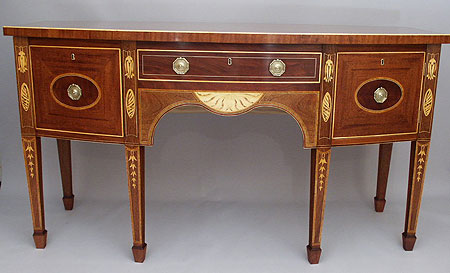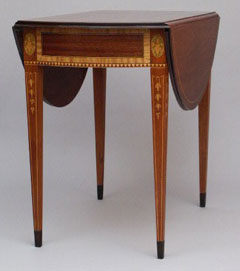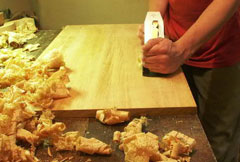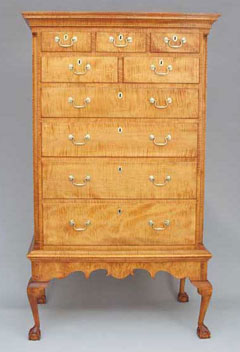
Some people see their destiny from day one; others need to get hit with a roof truss to see theirs. Apparently, Rob Millard is one of the latter.
Millard is an outstanding cabinetmaker who creates accurate period reproductions, working with the same tools and techniques used by the original woodworkers from the period. Working out of a one car garage in his home, he specializes in Federal style, but also does William and Mary, Queen Anne, and Chippendale. “I copy everything,” he told me. “I’ve never designed any of the furniture I make.”
Like his predecessors, Rob uses hand tools to create everything from carved ball-and-claw legs to the complex sand-shaded inlaid borders, medallions, and stringers so common to Federal furniture. “Initially, I started doing Chippendale and Queen Anne furniture. Around 1998, someone asked me to do a Federal period Pembroke table, and that started me in veneering. I don’t buy any parts; I make all my own inlays. I learned cutting and sand shading after reading about them.”

Although he had an early interest in woodworking, it took a substantial life detour for him to get on track with what he does now. “My grandfather was a carpenter who made some crude furniture,” Millard recounted, “but because he had a stroke when I was ten, I never actually saw him work in the shop. In the seventh grade, I had an industrial arts class in school, and got interested in woodworking. My first tool, bought when I was fourteen, was a Stanley number seven jointer plane. I still use it every day. For a lot of things, hand tools are faster and more efficient than power tools.”
He did not know it, but discouragement was just around the corner. “I made a table in tenth grade woodshop and got a ‘D’ on it,” Millard recalled. “That discouraged me a bit. As a result, I went to a vocational school for carpentry during my last two years of high school, and started working as a carpenter right after graduation in 1984.”
Just when it seemed as if he was destined to miss his true calling, fate intervened. “In 1994, I got hit with a roof truss, and that temporarily prevented me from working as carpenter. In retrospect, it was the best thing that ever happened to me. I took a job at a machine shop making production parts. To be honest, I don’t even know what they were for, although I made them for seven years.”

“Because I was being paid by the part and only had to do a certain number per week, I worked only about ten or fifteen hours per week, and never more than two days per week. At the time, I was making $30 per hour, the cost of living was low in Dayton, and I have no kids or wife, so I was doing fine and had time to spare. While at the machine shop, I came to realize how much I had hated the carpentry work, and decided never to return once my back healed.”
In 1996, he saw an article on making a cherry highboy in a woodworking magazine. That inspired him to make period furniture, and with all that free time, he could do it. “Every time I see that guy who gave me the job at the machine shop,” Rob admitted, “I thank him for the opportunity he afforded me.” Next, he bought some books and lumber and went at it, making a drop leaf table and a couple of candle stands. “Except for the finish,” he says “they turned out fine.” In early 2002, he quit the machine shop and dedicated himself to furniture full time.
Everything he learned turning, fluting, carving, veneering, finishing is self-taught. He’s never taken classes, but says he’s read everything he could get his hands on. He especially favors museum catalogs and books that describe in detail how pieces were built. Even his learning style is reminiscent of Old World methods. “I had never made a dovetail, so I bought a cheap dovetail saw, went out into the garage, hammered the set out of the teeth, took two pieces of birch, and kept making dovetails until I got it right.” Rob says it took him less than a day to get the skill in his hands.

Making furniture and selling it are two different things, and that was the next hurdle to leap. “I went to a couple of local woodworking shows in 1998 and 1999, but my finishes were holding me back. Early on, I was overly influenced by a book by Tom Teller and Ron Clarkson. Their finishes were terrible, and I was basing my finishes on theirs. My finishes were brushed shellac, and they came out rough. They simply did not have the silky feel that rubbed-out finishes have.”
“Eventually, one of the judges at a show told me ‘Your finishes are terrible; you would have won an award but for them.’ Oddly enough, his finishes were also terrible. I discovered that after he told me to come to a class he was giving at a local lumberyard. I saw a table he had made, and realized he had nothing to teach me. I went home and started making samples on scrap boards until I got them where I like them. I started filling the grain, applying more coats, and rubbing out the finish.”
“One of the first things people notice about my pieces is that the wood is alive and vibrant. That’s because I oil the wood as one of the first steps in finishing. I don’t know how to describe it, but the transformation is unbelievable. Because I lost that contest, these days I am a fanatic about finishes, and rub them all.”
Others have noticed. Millard has been named as one of the best 200 craftsman in America by Early American Life Magazine every year since 1999. One of his pieces, a carved finial, was displayed on the White House Christmas tree in 1999. In spite of the accolades, Rob humbly represents what he does as something simple and straightforward.

“I’ve always wanted to make something that I could see. I like taking a bunch of rough boards and a few scraps of veneer and making it into something that looks nice and feels smooth. No matter how complicated a piece of furniture looks, it all boils down to sawn, chiseled, or planed to a line.”
Considering the quality of Millard’s work, that may well be one of the grandest understatements of the year.





